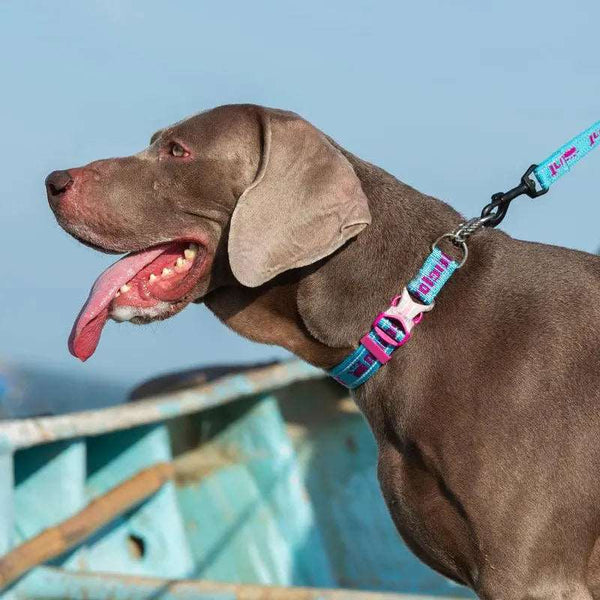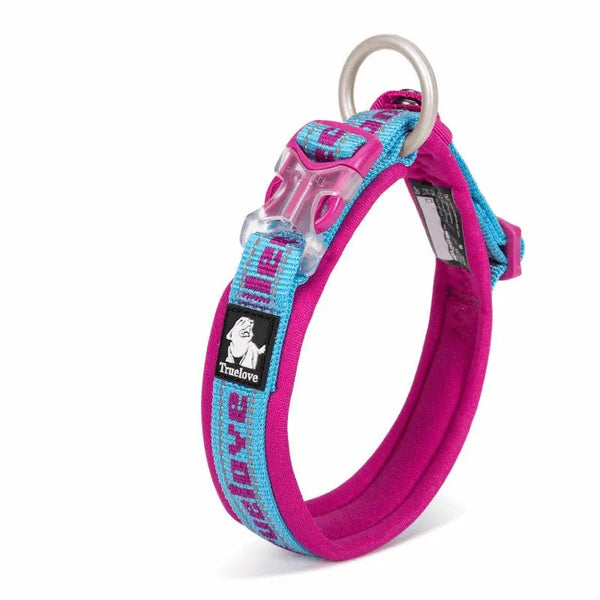Dog Harness vs Collar: Which Is Better for Your Pet’s Safety?
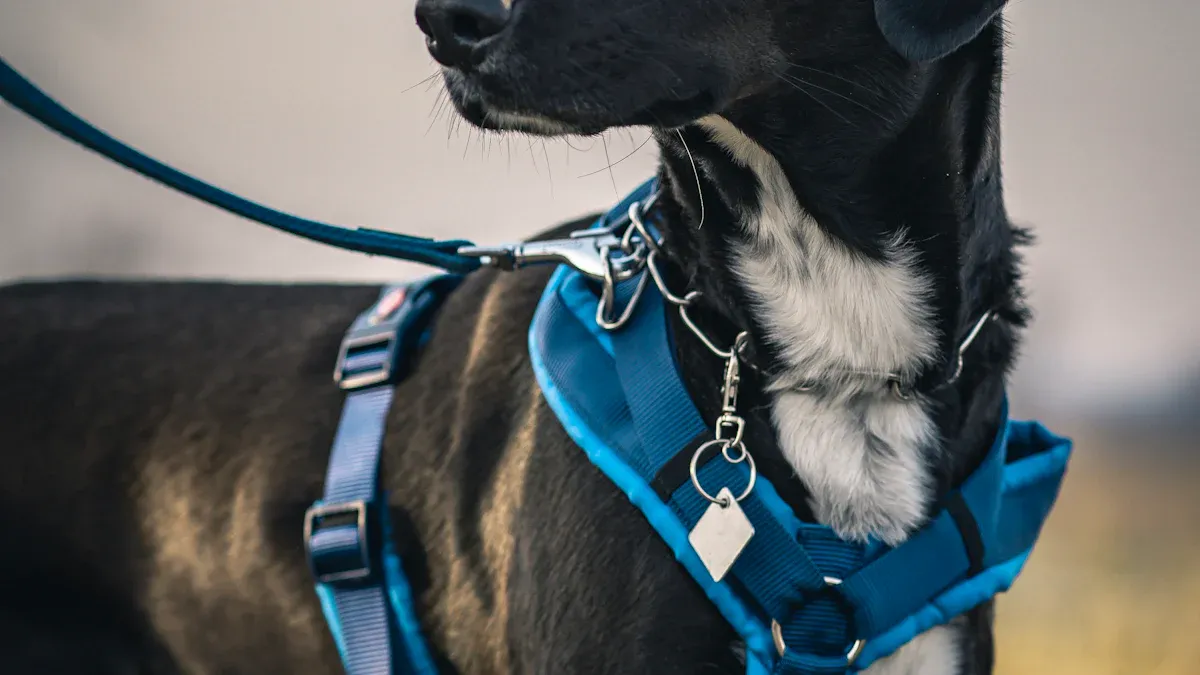
When you think about dog harness vs collar, you want your pet to be safe. For most dogs, a harness is usually safer than a collar. This is true if you worry about neck injuries or need more control. Studies show collars can put a lot of pressure on a dog’s neck. Sometimes, this pressure can reach up to 141 Newtons. Harnesses spread out the force and help stop injuries. Every dog is different, though. You should always think about your dog’s size, breed, and how they walk. Products like the Gabby Whale LED Smart Dog Harness give comfort, visibility, and control. If you like a dog collar, the Gabby Whale Half Choke Neoprene Dog Collar gives a safe and visible fit for calm dogs.
Key Takeaways
-
Harnesses spread out pressure on your dog’s body. This helps stop neck injuries. Walks are safer, especially for dogs that pull or have health problems.
-
Collars are good for calm, trained dogs and short walks. They also hold ID tags. This helps keep your dog safe if it gets lost.
-
Picking the right fit is very important. A snug, comfy harness or collar stops discomfort. It also helps you control your dog better during walks.
-
Harnesses give better control for strong or active dogs and puppies. They help guide your dog gently. They do not hurt your dog’s neck.
-
Most vets and trainers say harnesses are safer and more comfortable. But collars are still needed for ID tags and quick trips.
Dog Harness vs Collar: Quick Comparison
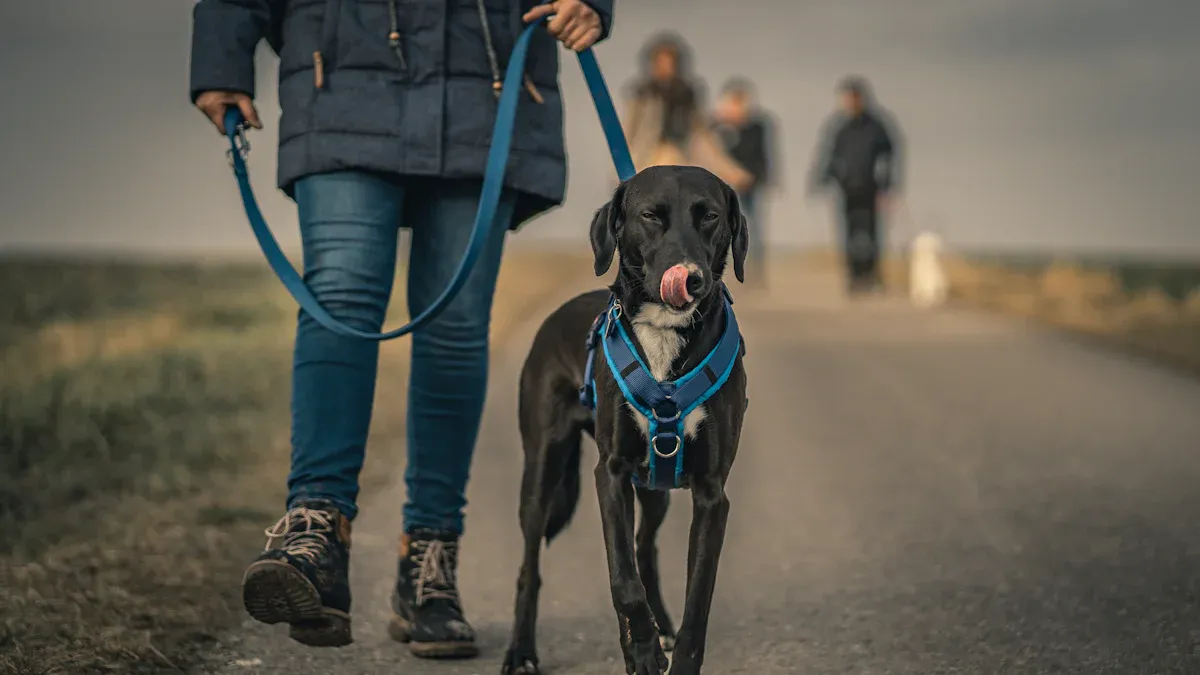
When you look at the dog harness vs collar debate, it helps to see a clear side-by-side comparison. Here’s a quick table to show you how harnesses and collars stack up for safety, comfort, control, and convenience:
|
Aspect |
Dog Collars |
Dog Harnesses |
|---|---|---|
|
Safety |
Risk of neck injury if your dog pulls; may detach unexpectedly |
Distributes pressure across the body, reducing neck injury risk; safer when properly fitted |
|
Comfort |
Minimalist design; easy to put on and take off |
Can cause chafing if not fitted right; generally comfortable when adjusted properly |
|
Control |
Limited control, best for calm or well-trained dogs |
More control, especially for large or pulling dogs; front-clip harnesses help discourage pulling |
|
Convenience |
Quick and easy to put on; usually less expensive; holds ID tags |
Takes more time to fit and adjust; needs strap checks as your dog grows or changes weight |
Let’s break down each area so you can decide what works best for your dog.
Safety
You want your dog to stay safe on every walk. Collars can put a lot of pressure on your dog’s neck, especially if they pull or lunge. This pressure can lead to neck injuries, breathing problems, or even eye issues. Some studies show that collars can cause chronic pain and anxiety in dogs. If your dog pulls, a harness is usually the safer choice. Harnesses like the Gabby Whale LED Smart Dog Harness spread the force across your dog’s chest and back. This design helps prevent tracheal damage and neck strain. Vets often recommend harnesses for dogs with respiratory issues or for breeds with short noses. You also get extra safety features with harnesses, like reflective strips and LED lights, which make your dog more visible at night.
Tip: If your dog has a history of neck or back problems, always choose a harness for walks.
Comfort
Comfort matters for both you and your dog. Collars feel light and simple. They work well for short walks or for dogs that never pull. But if your dog wears a collar all day, it can rub or cause irritation. Harnesses, when fitted right, offer more comfort for longer walks. The Gabby Whale Step-In Dog Harness uses soft padding and breathable mesh, so your dog stays cool and comfy. If you pick a harness, make sure you adjust it to fit snugly but not too tight. A loose harness can chafe, while a tight one can pinch.
Control
Control is key, especially if your dog gets excited or pulls on the leash. Collars give you less control, so they work best for calm or well-trained dogs. If your dog pulls, a harness gives you much more control. The Gabby Whale No Pull Dog Harness has a sturdy back handle and a front-clip option. This setup helps you guide your dog and stop pulling without hurting their neck. Trainers often suggest harnesses for puppies or strong dogs because you can steer them safely and gently.
Convenience
You want gear that fits your routine. Collars are quick and easy. You just snap them on, and you’re ready to go. They also hold your dog’s ID tags, which is important for safety. The Gabby Whale Half Choke Neoprene Dog Collar is easy to adjust and has reflective stitching for night walks. Harnesses take a little more time to put on and adjust. You need to check the straps, especially if your dog is growing or losing weight. But once you get the fit right, harnesses like the Gabby Whale LED Smart Dog Harness offer extra features like a GPS tracker holder and quick-release buckles.
Ready to upgrade your dog’s walks? Check out the Gabby Whale harness and collar collection for options that fit your dog’s needs and your lifestyle.
When a Harness Is Safer
Pressure Distribution
You want your dog to feel safe and comfortable on every walk. A harness spreads pressure across your dog’s chest and back, not just the neck. This makes a big difference, especially if your dog pulls or gets excited. Clinical research shows that collars put a lot of pressure on the neck. This can lead to breathing problems or even tracheal collapse, especially in small breeds or dogs with short noses. Harnesses, on the other hand, reduce this risk by moving the force away from the throat.
Veterinary specialists have found that front-attachment harnesses can lower tracheal pressure by up to 90% compared to collars. This is important for any dog, but it’s even more critical for brachycephalic breeds or those with existing respiratory issues. If you’re wondering whether to use a collar or harness for a puppy, a harness is usually the safer bet. Puppies have delicate necks, and a harness gives them gentle support as they learn to walk on a leash.
The Gabby Whale LED Smart Dog Harness stands out here. It uses a breathable mesh and adjustable straps to fit your dog perfectly. The LED light and reflective strips add extra safety for night walks. You also get a GPS tracker holder, so you always know where your dog is.
Tip: Choose a harness with a snug, comfortable fit to keep your dog happy and safe on every adventure.
Injury Prevention
No one wants to see their dog hurt. Injuries from collars can happen quickly, especially if your dog pulls or lunges. Studies show that about 70% of dog owners deal with leash-pulling. When you use a collar, this pulling can cause neck injuries, throat strain, or even damage to the eyes. Harnesses help prevent these injuries by spreading the force over a larger area.
Veterinarians like Dr. Erica Tramuta-Drobnis say that collars can put too much pressure on the trachea and spine. This is risky for small dogs, puppies, or any dog with breathing problems. Harnesses move the pressure away from these sensitive spots. They also help dogs with orthopedic or neurological issues by supporting the body and reducing pain.
The Gabby Whale No Pull Dog Harness is a great choice if you want to prevent injuries. It has a sturdy back handle for extra control and reflective stitching for night safety. The four-point adjustment system means you can get the perfect fit, which is perfect for puppies or growing dogs.
If you want to keep your dog safe and avoid injuries, try a harness designed for comfort and control. Check out the Gabby Whale harness collection for options that fit every dog.
Control for Pullers and Puppies
If your dog pulls on the leash, you know how hard it can be to keep control. Collars don’t give you much help here. They can even make pulling worse and increase the risk of neck injuries. Harnesses give you more control, especially with front-clip designs. Trainers like Kim Erickson recommend harnesses for training because they help redirect your dog’s movement without causing pain.
Puppies need gentle guidance as they learn to walk. A harness is perfect for puppies because it supports their body and keeps their neck safe. The Gabby Whale Step-In Dog Harness makes walks easy. It has soft padding, a quick-clip buckle, and reflective strips for safety. You can adjust it to fit your puppy as they grow.
Want better control and a safer walk? Try a harness with ergonomic handles and reflective features. Your dog will thank you!
Ready to make the switch? Explore Gabby Whale’s range of harnesses—LED Smart, No Pull, and Step-In models—to find the best fit for your dog’s needs and your peace of mind.
When a Collar Works Best
Calm or Trained Dogs
You might find a collar works best if your dog is calm or already trained to walk beside you. Trainers often say that collars can cause injuries if your dog pulls hard. For dogs that walk gently and listen well, a collar gives you a simple way to attach a leash. You avoid the risk of neck strain because your dog doesn’t lunge or tug. Studies show that traditional collars don’t work well for dogs that pull, but they suit calm dogs who know how to behave on walks. If you have a puppy learning to walk, you may want to start with a harness, but once your dog matures and walks calmly, a collar becomes a good choice.
The Gabby Whale Half Choke Neoprene Dog Collar stands out for these dogs. It offers reflective stitching for visibility and soft padding for comfort. You get adjustability for a perfect fit, which helps keep your dog happy on every walk.
Short Walks and ID Tags
Collars shine during short walks or quick trips outside. Most places require your dog to wear a collar with an ID tag in public. This rule helps keep your pet safe if they ever get lost. Almost every dog owner needs to follow this law, so a collar is a must-have. Flat or engraved tags work best because they don’t snag or make noise. Many pet parents keep a collar on their dog all day for easy identification.
-
99.9% of dogs in the UK must wear a collar with ID in public.
-
Flat tags reduce the risk of snagging during walks.
-
Collars with engraved plates keep your contact info handy.
The Gabby Whale Reflective Dog Collar makes these walks safer. It has 3M reflective strips for night safety and a quick-release buckle for easy use. You can adjust it for comfort, and it holds ID tags securely. Looking for a reliable collar? Check out the Gabby Whale collection for options that fit your dog’s needs.
Risks for Pullers or Health Issues
Not every dog should use a collar for walks. If your dog pulls, a collar can put too much pressure on the neck. This can lead to injuries or breathing problems. Dogs with respiratory issues or certain breeds with short noses need extra care. Trainers and vets often suggest harnesses for these dogs. You want to keep your dog safe, so always watch how they behave on walks. If you notice coughing, gagging, or discomfort, switch to a harness right away.
Tip: For dogs that pull or have health concerns, try a harness like the Gabby Whale No Pull Dog Harness for better control and safety.
A collar works best for calm dogs, short walks, and holding ID tags. Always choose the right gear for your dog’s comfort and safety.
Collar vs Harness: Choosing for Your Dog
Size and Breed
When you look at the collar vs harness debate, your dog’s size and breed matter a lot. Small breeds like Chihuahuas or Pugs often have delicate necks. A harness works better for them because it protects their throat during walks. Large breeds, like Labradors or Huskies, need strong gear. The best harness for large dogs, such as the Gabby Whale No Pull Dog Harness, gives you control and comfort. If you have a toy breed or a brachycephalic dog, a harness is usually safer. For medium or calm dogs, a collar like the Gabby Whale Reflective Dog Collar can work well for short walks and ID tags.
Health and Behavior
Think about your dog’s health and how they act on walks. Dogs with breathing issues or neck problems should avoid collars. A harness, like the Gabby Whale LED Smart Dog Harness, spreads pressure and keeps your dog safe. If your dog pulls or gets excited, a harness helps you guide them without hurting their neck. Calm, well-trained dogs may do fine with a collar for daily walks. Always check with your vet or a trainer if you’re unsure. They can help you pick the right gear for your dog’s needs.
Tip: If your vet says your dog should not wear a collar, attach ID tags to the harness instead.
Walking Habits
Your daily routine shapes your choice. Do you take long walks or quick trips outside? For long walks, a harness offers more comfort and control. The Gabby Whale Step-In Dog Harness is easy to put on and keeps your dog comfy on every walk. If you only go for short walks or need a way to hold ID tags, a collar is simple and quick. Training a new puppy? Choosing a harness helps teach good leash habits and keeps your walks stress-free.
Here’s a quick checklist to help you decide:
-
Large, strong dog? Look for the best harness for large dogs.
-
Calm, trained dog? A collar may be enough for short walks.
-
Pulls on leash or has health issues? Go with a harness.
-
Need ID tags? Use a collar or attach tags to the harness.
Ready to upgrade your walks? Explore Gabby Whale’s harness and collar collection to find the perfect fit for your dog.
Best Harness for Active Dogs
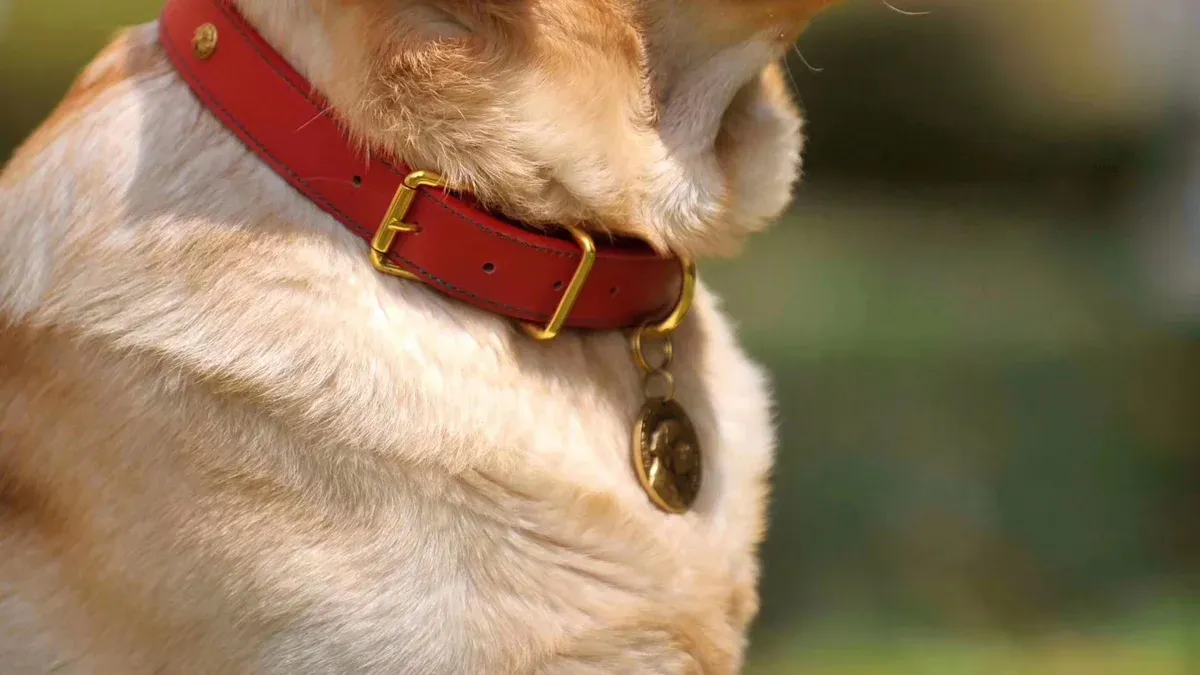
Key Features
If you love outdoor adventures with your dog, you know how important the right gear is. The best harness for active dogs needs to handle rough play, long hikes, and even a splash in the water. You want a harness that keeps your dog safe and comfortable, no matter where you go.
Here’s what you should look for:
-
Durability: Choose a harness made from strong nylon or weather-resistant fabric. Many harnesses tested in labs use heavy-duty stitching and secure D-rings for safety.
-
Breathability: Look for padding with neoprene or mesh. These materials keep your dog cool and dry, even on hot days or after a swim.
-
Reflective Elements: Reflective strips or trims help cars and people see your dog during early morning or evening walks.
-
Control Handles: A sturdy handle on the back gives you extra control. You can help your dog over rocks or into the car with ease.
-
Quick-Dry and Water-Resistant: If your dog loves water, pick a harness that dries fast and resists water damage.
Many pet owners now want harnesses that offer comfort, safety, and control for outdoor activities like hiking, running, or camping. Market research shows that more people choose harnesses with features like reflective materials, padded straps, and even GPS tracking for peace of mind.
Tip: Always check the fit before every adventure. A snug, comfortable harness keeps your dog happy and safe.
Product Options
You have great choices when it comes to harnesses for active dogs. Two top picks stand out:
-
Gabby Whale No Pull Dog Harness: This harness uses high-quality nylon webbing and breathable mesh. It has a four-point adjustment system, so you get a perfect fit. The sturdy back handle gives you control in tricky spots, and reflective stitching keeps your dog visible at night. Quick-release buckles make it easy to put on and take off.
-
Gabby Whale LED Smart Dog Harness: This harness is perfect for evening walks or hikes. It features a rechargeable LED light with multiple flash modes, reflective strips, and a GPS tracker holder. The ergonomic traffic handle helps you guide your dog safely, and the breathable mesh keeps your dog cool.
Both harnesses are built for adventure and comfort. If you want the best harness for active dogs, check out the Gabby Whale collection. Your dog will love the freedom, and you’ll love the peace of mind.
Ready to upgrade your dog’s outdoor gear? Explore Gabby Whale’s harnesses and find the perfect match for your next adventure!
Collar vs Harness: Product Comparison
| Dog Type / Behavior | Recommended Gear | Link |
|---|---|---|
| Pulling or strong dogs | No Pull Harness | Shop Now |
| Night walks | LED Smart Harness | Shop Now |
| Calm, trained dogs | Reflective Dog Collar | Shop Now |
| Small dogs or puppies | Step-In Harness | Shop Now |
Tips for Safe Use
Proper Fit
Getting the right fit for your dog’s harness or collar makes all the difference. Start by measuring your dog’s chest girth and neck circumference. This helps you pick the correct size, whether you choose a dog harness or a dog collar. Adjustable straps are your best friend here. They let you customize the fit as your dog grows or changes shape. Look for harnesses made from soft, durable materials that won’t rub or irritate your dog’s skin. Experts say a properly fitted harness should feel snug but still let your dog move freely, especially in the shoulders and legs. You want to avoid any pressure points that could cause discomfort or affect your dog’s walk.
-
Always check the fit before every walk.
-
Use the markings and adjustment points on your Gabby Whale LED Smart Dog Harness or No Pull Dog Harness for a secure fit.
-
Make sure you can slip two fingers between the harness and your dog’s body.
Choosing the right fit keeps your dog safe and happy. Properly fitted harnesses also give you better control and help prevent injuries.
Monitoring Comfort
You want your dog to enjoy every walk. Watch for signs of chafing, redness, or discomfort around the harness or collar area. If your dog scratches, bites, or tries to wiggle out, the fit might be off. Some pet owners use smart monitors like the Waggle PRO+ to track temperature and humidity, making sure their dog stays comfortable in all weather. Many Gabby Whale harnesses have breathable mesh and reflective strips, so your dog stays cool and visible. Check the harness during and after walks, especially if your dog is active or loves to roll around.
-
Look for soft padding, like in the Gabby Whale Step-In Dog Harness, to prevent rubbing.
-
Clean and inspect your gear often to keep it in top shape.
Tip: If you notice any discomfort, adjust the straps or try a different harness style.
Switching Gear
Sometimes, you need to switch between a harness and a collar. Maybe your dog is calm and only needs a collar for short walks or ID tags. If your dog starts pulling or has health issues, switch to a harness for better support. Trainers and vets often recommend harnesses for dogs that pull or have breathing problems. Modern harnesses, like the Gabby Whale LED Smart Dog Harness, let you add GPS trackers or reflective accessories for extra safety. If you walk at night or in busy areas, a harness with LED lights or reflective strips can make a big difference.
-
Use a collar for quick trips and ID tags.
-
Choose a harness for training, long walks, or if your dog pulls.
-
Upgrade to a properly fitted harness with extra features for active dogs.
Want to keep your dog safe and comfortable? Explore Gabby Whale’s harness and collar collection to find the perfect match for your next adventure!
Common Myths About Dog Walking Gear
-
Myth: Collars are always fine for any dog.
Reality: Collars may cause throat injury in strong pullers or dogs with respiratory issues. -
Myth: Harnesses are only for big dogs.
Reality: Small dogs and puppies also benefit from step-in harnesses designed for their size.
Expert Recommendations
Veterinary Advice
When you want the best for your pet, listening to veterinarians makes sense. Many vets say harnesses are safer than collars, especially for dogs that pull or have delicate necks. Experts like Mo Lynch Vashel and Pamela Brown recommend harnesses to prevent neck and tracheal injuries. They point out that even padded or wide collars do not lower the risk of soft tissue damage. Vets often suggest harnesses with both front and back clips for better control and comfort. If you have a small breed or a puppy, a harness like the Gabby Whale LED Smart Dog Harness can help protect your pet’s neck and keep walks safe. The LED light and reflective strips add extra safety, which vets love for night walks.
Note: Vets agree that harnesses are the best choice for long walks and active dogs.
Trainer Insights
Dog trainers want you to have control and keep your pet happy. Most trainers prefer harnesses, especially front-clip styles, for training and daily walks. They say harnesses help you guide your dog without causing pain. Trainers rarely recommend aversive collars like prong or choke collars. In fact, about 89% of trainers avoid citronella collars, and nearly 79% avoid choke collars. Trainers like harnesses because they make training easier and safer. The Gabby Whale No Pull Dog Harness is a favorite for its sturdy handle and four-point adjustment, making it great for training sessions.
-
Trainers support reward-based, non-aversive gear.
-
Certified trainers often recommend harnesses for better control.
When to Consult a Pro
Sometimes, you need extra help. If your dog has special needs, health issues, or tough behaviors, reach out to a vet or certified trainer. Over 30% of pet owners ask vets for general advice, but trainers are the go-to for behavior problems. If you notice pulling, coughing, or discomfort, switch to a harness and talk to a pro. They can help you choose the right gear, like the Gabby Whale Step-In Dog Harness or Reflective Dog Collar, for your pet’s unique needs.
Ready to find the perfect fit? Explore Gabby Whale’s harnesses and collars to keep your dog safe and happy on every walk!
Choosing the Right Gear: A Pet Parent’s Perspective
Real-Life Scenarios
Choosing between a harness and a collar can feel tricky. You want your pet to be safe and happy, but every dog is different. Let’s look at some real-life situations pet parents face:
-
You have a big, strong dog like a Labrador. Walks feel like a tug-of-war. Many pet parents in your shoes switch to a no-pull harness, like the Gabby Whale No Pull Dog Harness. It gives you more control and keeps your dog comfortable.
-
Your dog is small and loves to dart around. You worry about neck strain. A lightweight harness, such as the Gabby Whale Step-In Dog Harness, spreads out the pressure and helps protect your dog’s throat.
-
Your pup is calm and walks gently by your side. You might prefer a collar for quick walks and holding ID tags. The Gabby Whale Reflective Dog Collar offers safety with its reflective stitching and easy fit.
-
You walk your dog at night or in busy areas. Visibility matters. The Gabby Whale LED Smart Dog Harness lights up your walks and keeps your pet seen.
Pet parents often choose harnesses for large breeds or dogs that pull. Trainers and vets recommend harnesses for safety and comfort, especially for active or young dogs.
Decision Tips
You want to make the best choice for your furry friend. Here’s a simple table to help you decide:
|
Situation |
Best Gear Choice |
Why It Works |
|---|---|---|
|
Pulls on leash |
No Pull Harness (Gabby Whale) |
More control, less neck strain |
|
Calm, trained, short walks |
Reflective Collar (Gabby Whale) |
Easy, holds ID, quick to use |
|
Small breed or puppy |
Step-In Harness (Gabby Whale) |
Gentle support, protects neck |
|
Night or low-light walks |
LED Smart Harness (Gabby Whale) |
High visibility, extra safety |
|
Health or breathing issues |
Adjustable Harness (Gabby Whale) |
Spreads pressure, reduces injury risk |
Tip: Watch your dog’s comfort and behavior. If you see rubbing, pulling, or signs of discomfort, adjust the fit or try a different style. Experts say the right fit makes all the difference.
Ready to find the perfect match? Explore the Gabby Whale harness and collar collection to keep your walks safe and stress-free!
You want your dog to stay safe and happy on every walk. For most pets, a harness like the Gabby Whale LED Smart Dog Harness offers better safety and control than a collar. Still, your choice should fit your dog’s size, habits, and health. Experts like vets and trainers suggest checking the fit often and watching for comfort. If you need help, ask a pro. Ready to find the right gear? Explore Gabby Whale’s harness and collar collection today!
FAQ
Can I leave a harness on my dog all day?
You shouldn’t leave a harness on your dog all day. Harnesses like the Gabby Whale LED Smart Dog Harness work best for walks or outings. Take it off at home to prevent rubbing or discomfort. Your dog will thank you for the break!
Which is better for puppies: harness or collar?
A harness is safer for puppies. It protects their neck and gives you gentle control. The Gabby Whale Step-In Dog Harness fits small pups well. Trainers often suggest starting with a harness for leash training.
How do I know if my dog’s harness fits right?
Check the fit by sliding two fingers under the straps. The harness should feel snug but not tight. Look for signs of rubbing or discomfort. Adjustable options like the Gabby Whale No Pull Dog Harness make it easy to get the perfect fit.
What do vets and trainers recommend for dogs that pull?
Most vets and trainers say you should use a no-pull harness for dogs that pull. It gives you more control and keeps your dog’s neck safe. Try the Gabby Whale No Pull Dog Harness for better walks.
Ready to upgrade? Shop Gabby Whale harnesses now!
Do collars still matter if I use a harness?
Yes! Collars hold ID tags, which help if your dog gets lost. The Gabby Whale Reflective Dog Collar keeps your dog visible and safe. Use both for the best safety.
Tip: Always keep ID tags on your dog, even when using a harness.
See Also
Comparing Bear Pet Bowls And Classic Dog Bowls For Pets
Should Dogs Wear Their Harnesses Throughout The Entire Day?
The Importance Of Gabby Whale Reflective Collars For Night Safety
Key Advantages Of Gabby Whale Reflective Leashes For Walking Dogs
Gabby Whale Rope Leash: Best Pick For Energetic, Adventurous Dogs



